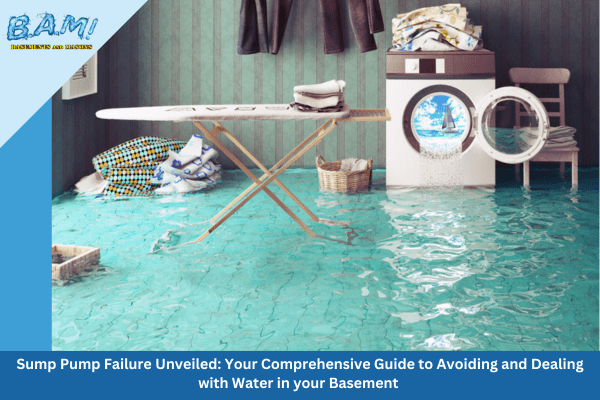Common Causes of Sump Pump Failure
Power Outage: One of the most common reasons for sump pump failure is a power outage. When the electricity goes out, your sump pump may not work if it relies solely on electrical power. To avoid having this issue, consider investing in a battery backup system for your sump pump, which keeps it running during power outages.
Incorrect Installation: Improper installation can significantly increase the risk of sump pump failure. The pump must be installed correctly to ensure that it operates efficiently and correctly. This includes proper positioning, ensuring the discharge pipe is clear, and adequate drainage around the sump pit.
Lack of Maintenance: Sump pumps require regular maintenance and inspections to keep them in good working condition. Neglecting maintenance can lead to various problems like clogs, worn-out parts, and reduced efficiency. Regularly clean the sump pit, test the pump, and inspect for any signs of wear or damage.
Overwhelmed Pump: During heavy rain storms or flooding events, your sump pump may become overwhelmed by the volume of water it needs to pump out. An undersized pump or a pump that is not functioning at its full capacity can easily fail in these situations. It’s essential to ensure your sump pump is appropriately sized for your needs and is in good working condition.
Age and Wear: Like all mechanical equipment, sump pumps have a finite lifespan. The average sump pump can last anywhere from 5 to 15 years, depending on factors such as usage and maintenance. As the pump ages, its components can deteriorate, increasing the risk of failure. Regularly replace your sump pump when it nears the end of its expected lifespan.
Signs of Sump Pump Failure
Unusual Sounds: One of the first signs of sump pump trouble is unusual sounds. If your pump begins to make loud or unusual noises, such as grinding or clunking, it may indicate a mechanical issue or obstruction. Investigate and address the problem promptly to prevent a complete failure.
Frequent Cycling: Sump pumps typically cycle on and off as they remove water from the pit. However, if you notice that your pump is constantly running without a break or frequently cycling on and off, it could be a sign of a problem. This behavior may indicate that the pump is struggling to keep up with incoming water or that there is a malfunction.
Water in the Basement: The most obvious sign of sump pump failure is water in the basement. If your sump pump is not working correctly or has failed entirely, water will accumulate in the sump pit and eventually overflow into your basement. It’s crucial to address this issue immediately to minimize water damage and mold growth.
Foul Smelly Odors: When water stands stagnant in the sump pit due to pump failure, it can lead to the growth of mold, mildew, and bacteria. This can result in foul odors coming from the basement. If you notice musty or unpleasant smells, it’s a clear indication that there’s a problem with your sump pump.
Preventive Measures to keep sump pump running
Regular Maintenance: Prevention is often the best approach to avoid sump pump failure. Regular maintenance is key to keeping your sump pump in good working condition. Perform the following maintenance tasks at least once a year:
Clean the sump pit and remove any debris or sediment.
Test the pump by pouring water into the pit and ensuring it activates.
Inspect the float switch to ensure it moves freely.
Check all electrical connections for signs of corrosion or damage.
Replace any worn or damaged components.
You can also contact a basement waterproofing company to do yearly maintenance checks for you.
Battery Backup Systems
To protect against power outages and primary pump failure, consider installing a battery backup system. Battery-operated backups rely on a battery to power the pump during outages. This can provide an extra layer of security against sump pump failure.
Proper Sizing: Ensure that your sump pump is appropriately sized for your needs. A pump that is too small may struggle to keep up with heavy rainfall or flooding, leading to failure. Consult with a Basement sump pump professional to determine the right size pump for your specific situation.
What to Do When Sump Pump Failure Happens
First thing is make sure the sump pump is plugged in and the breaker hasn’t tripped.
Troubleshoot the Sump Pump: After addressing the immediate issue, troubleshoot your sump pump to determine the cause of the failure. Check for any clogs, inspect the float switch, and examine the electrical connections. If you’re unsure or find any significant issues, it’s best to consult a basement waterproofing company for repairs or replacement.
Stay Safe: If you discover sump pump failure and water in your basement, your safety should be your first priority. Avoid standing water, as it can pose electrical and health hazards. Turn off the electricity to the affected area to minimize the risk of electrical shock.
Address the Immediate Issue: If your sump pump has failed, take immediate action to remove the standing water. You can use a wet-dry vacuum, a sump pump backup system, or call a professional water remediation service to assist you. The faster you address the problem; the less damage will occur.
Prevent Future Failures
To prevent future sump pump failures, take the following steps:
Invest in a high-quality sump pump and consider a battery or water-powered backup.
Schedule regular maintenance and inspections.
Install an alarm system that alerts you to sump pump issues.
Consider installing a secondary sump pump for added peace of mind.
Sump pump failure is a homeowner’s nightmare, but with proper maintenance and preventive measures, you can significantly reduce the risk of it happening. Regularly inspect and maintain your sump pump, invest in backup systems, and be prepared to take swift action in case of failure. By understanding the common causes and signs of sump pump failure, you can protect your home and valuables from water damage, ensuring a dry and safe environment for years to come.
Call the Sump Pump pros!
If you find yourself worrying about your sump pump or needing a replacement sump pump or battery backup, call BAM Basements and Masons of Des Moines. We offer free estimates and upfront honest opinions. We can take a look at your sump pump and recommend the best solution for you and your home. We are locally owned and operated, insured, A+ BBB rating and have the low side of fair pricing. BAM Basements and Masons of Des Moines is your premier sump pump installation company serving the Des Moines, Iowa area. If you’re located in Des Moines, Ankeny, Bondurant, Altoona, Pleasant hill, Ames, Adel, Waukee, Indianola, Grimes, Urbandale, Johnston, West Des Moines, or the surrounding areas, we’re the place to call.


